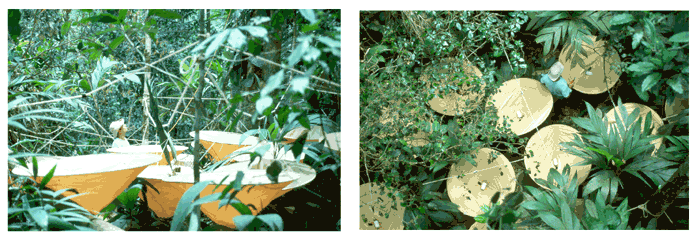 |
|
|
||||
|
|
|
|
|
|
|
|
 |
|
|||||
|
|
|
|
|
|||
|
|
|
|
|
|||
|
|
|
|
||||
|
|
|
|||||
|
|
|
|
||||
 |
 |
|
||||
|
|
|
|||||
|
|
|
|||||
|
|
|
|||||
|
|
|
|||||
 |
|
| Berlese samples |
|
| Canopy Fogging samples | |
| Flight-intercept samples | |
| Blacklight | |
| Malaise samples | |
| Pitfall samples | |
| Salticidae Project | |
|
Canopy Fogging Samples During the 1993-1994 sampling period, eighteen trees were selected for canopy fogging: 6 individual trees of the most common tree species at La Selva (Pentaclethra macroloba (Willd.) O. Ktze., Fabaceae), 6 individual trees of a species of intermediate abundance (Virola koschnyi Warb., Myristicaceae), and one individual each of trees from six additional families. Six areas were chosen on a La Selva station map, such that the areas were dispersed across the available primary forest, and at the same time accessible from the trail system. In each area three trees were selected: a Pentaclethra, a Virola, and one of the six unique species. We chose trees that had large crowns, little overlap with adjacent crowns, and good access for climbing. The three trees in a group were usually fogged on consecutive days, and the 6 groups were fogged at approximately two-month intervals over one calendar year. A second set of fogging samples was obtained in October and November of 1994. 7 sets of 3 trees were fogged, all compressed into this 2-month period instead of spread over a year. Again each group of three contained a Pentaclethra macroloba, a Virola koschnyi, and a distinct species in the "other" category. 6 of the groups were new trees at new locations. 1 of the groups was a set previously fogged: events 13, 14, and 15 were fogged on 6-9 Nov 1993, and the same trees, events 28, 29, and 30, respectively, were fogged 22-24 Oct 1994. On the day prior to fogging a tree, the tree was rigged with mountain-climbing ropes and a pulley system, so that the following day an operator could climb to the lower branches of the crown and the fogging machine could be hoisted on pulleys. Ropes were strung from trunk to trunk between the focal tree and neighboring trees to form an irregular network 2-3m high above ground level. Forty funnels, each intercepting an area of 1 square meter, were suspended from these ropes, distributed as evenly as possible in the area beneath the crown of the focal tree. (Nigel Stork had these funnels made for another project in Costa Rica, and very generously donated them to the ALAS project.) The funnels were composed of ripstop nylon mounted on a metal hoop, with a threaded ring at the bottom for the attachment of a plastic sample bottle. Palm leaves and other vegetation immediately above the funnels were clipped or bent back, but otherwise the understory vegetation was left intact.
Funnels were left upside down on the ground overnight to avoid accumulation of debris before fogging. Before dawn the next morning the funnels were re-suspended and the bottles filled with 75% ethanol. An operator climbed to the first branches at the base of the crown, 15 to 20m above ground level, and commenced fogging at about 0600hrs. We used a Golden Eagle DynaFogger, on setting 6, to fog 3.8 l of Pyrethrins 123 insecticide (Summit Chemical Co.). This is a 3% solution of a natural pyrethrin insecticide with synergists, in a petroleum distillate carrier. The operator gradually fogged in a 360 degree circle, attempting to cover the crown evenly. Following fogging, a two-hour drop time was allowed, after which the sides of the funnels were washed down with ethanol and the bottles were collected. Subsequent fogging samples include the following: One sample was taken in January 1996. A set of 6 samples (41-46) were taken in late December 1999 and early January 2000. These were from diverse species in a variety of families, all from one area in primary forest. A set of 6 samples (47-52) were taken in May 2000, all from one species of tree. Three of these samples were taken using the usual procedure of climbing to the lower crown and fogging from there. Three other samples were taken by fogging from the ground. Fogging collection codes are of the form Faa/xx/yy, where "F" indicates it is a fogging sample, aa is a two-letter code (OT=other, a variety of species; PM=Pentaclethra macroloba, VK=Virola koschnyi), xx is a unique fogging event number, and yy is funnel number within a fogging event (1-40 funnels). List of fogging samples, by event number. |
